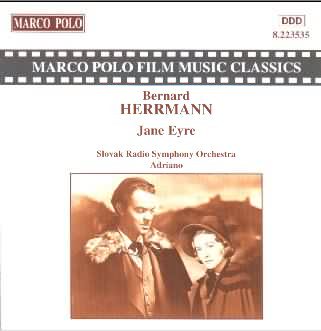Music Webmaster Len Mullenger |
||
Music Webmaster Len Mullenger |
||
Bernard HERRMANN
Jane Eyre (1943) Slovak (Bratislava) RSO/Adriano
Slovak (Bratislava) RSO/Adriano
|
|
|

This disc has been around since 1994 but Ian and I intend gradually catching
up with back catalogue as well as trying to keep pace with new releases.
The recent spate of Herrmann releases provided an excuse for returning to
this fine vintage score.
The Jane Eyre film starred Joan Fontaine as the grown-up Jane. Orson Welles was Mr Rochester. Welles at the same time controlled many other aspects of the film. Agnes Moorhead and Henry Danielle played the villains. The film plot is based on Charlote Brontë's novel.
This was Herrmann's 4th film score written between Magnificent Ambersons and Hangover Square. Also separates the score for the 1941 symphony and the Brontë opera Wuthering Heights which was written in same year as Jane Eyre.
From the very first moment of the first track it proclaims itself a Gothick romantic score for a gothic romantic story. The jumpy sleigh ride [2] is carefree but icily treacherous. This is a Herrmann trademark which can also be heard in the sledge music of Kane and the glorious marine fan-faring of the music for Beyond the Twelve Mile Reef. Much of the present score has a Sibelian edge. Try tracks 3, 9 and 13. Thornfield Hall [7] opens with an horrific machine room percussive episode. The Valse Bluette played on a (not at all offensive) synthesiser is a tinkling music-box waltz. Herrmann calls on all the glorious variety of his orchestral palette. Track 8 for example offers Eastern-edged and commanding sea music. Track 10 at 00.57 features a remarkably lovely extended oboe melody heard over undulatingly gently chugging strings. Track 12 has a village dance later cut through with roughhewn fanfares: a very original effect woven over an innocent Herrmann tune. Track 13 has a haunted beauty resolving into a nightmare of braying rather like something from the gloomiest pages of a Pettersson symphony. (I ask again did Herrmann know Pettersson's music or vice versa?). In track 16 there is yet more high work for the violins and a solo violin chastely serenades rather like Holst with a touch of pastoral Butterworth. The Wedding [18] has a satisfying theme with turns of melody over chugging deep strings; Tippett-like yearning under its fingernails. This is very British in feel. Like all the best Gothicry: in the midst of beauty suddenly the dust and mildew appear. In Jane's Farewell a plaintive oboe calls and laments. This is all unashamedly melodramatic with yet more high whistling strings and strangled distant fanfares. This music has a slightly crazed dream-storming character: Black clouds rush across a moonlit sky. In the finale we return to the big lamenting and exulting theme coursing over the shuddering deep strings.
This project was clearly a labour of love for the Swiss conductor Adriano who painstakingly reconstructed the score from a third generation photocopy and by listening through the dialogue and the patina of the years to the music on the soundtrack. He recreated the score in computer software and generated parts from the computer file.
There are fine notes by Adriano (Ed Keith Anderson) with plenty of background on the film, the music, its reconstruction and the place of the music in Herrmann's output. The booklet reproduces six stills from the film. A strongly recommended disc.
![]()
Rob Barnett
see also Bernard Herrmann web page
Return to September Film Music Reviews